air condition BMW X5 4.4I 2000 Owner's Manual
[x] Cancel search | Manufacturer: BMW, Model Year: 2000, Model line: X5 4.4I, Model: BMW X5 4.4I 2000Pages: 201, PDF Size: 1.93 MB
Page 129 of 201

IndexDataTechnologyRepairsCar careControlsOverview
129n
Tire replacement Tire rotation Tire age The date on which the tire was manu-
factured is indicated by the code on the
sidewall:
DOT ... 419 indicates that the tire was
manufactured in Week 41 of 1999.
BMW recommends the replacement of
all tires when the tires are no more than
6 years old, even if a tire life of 10 years
is possible.
Spare tires over 6 years old should be
used only in case of emergency. Such a
tire should be replaced by a new tire
immediately, and should not be
mounted together with new tires.
Between the axles The tread wear patterns at the front end
differ from those at the rear Ñ the actual
patterns will vary according to individ-
ual driving conditions. In the interests of
safety and maintaining optimal handling
characteristics, tire rotation is not rec-
ommended.
When considering the potential eco-
nomic benefits of interaxle tire rotation,
you must decide whether the expense
of having the tires rotated is likely to be
amortized during the anticipated exten-
sion in tire life. In principle, interaxle tire
rotation should be performed at short
intervals, with a maximum of
3,000 miles (5,000 km). Consult your
authorized BMW center for more infor-
mation.
Should you decide to rotate the tires, it
is essential that you comply with the
following:
Rotate tires on the same side only,
since braking characteristics and road
grip could otherwise be adversely af-
fected.
Following tire rotation, correct the tire
inflation pressure. If different tire sizes are mounted
on the front and rear axles (refer to
page 132), the wheels may not be ro-
tated from one axle to the other.<
Page 131 of 201

IndexDataTechnologyRepairsCar careControlsOverview
131n
Winter tires Snow chains
*
Choosing the right tire BMW recommends special winter tires
(M+S radial tires) for driving in adverse
winter road conditions. While the All-
Season tires with M+S designation that
are mounted as standard equipment
provide better winter traction than sum-
mer tires, they generally do not achieve
the performance of winter tires.
For safe tracking and steering re-
sponse, install winter tires made by the
same manufacturer having the same
tread configuration on all four wheels.
Mount only winter tires approved by
BMW. Any BMW center will be glad to
provide you with information for select-
ing the best winter tires for your partic-
ular driving conditions.
Do not exceed specified
maximum speeds
Never exceed the maximum
speed for which winter tires are
rated.
Unprofessional attempts by laymen to
service tires can lead to damage and
accidents.
Have this work performed by skilled
professionals only. Any BMW center
has the required technical knowledge
and the proper equipment and will be
happy to assist you.<
Tire condition, tire pressure Once winter tires wear to a tread depth
below 0.16 in (4 mm), their performance
under winter driving conditions deterio-
rates noticeably. Worn tires should
therefore be replaced for safety consid-
erations.
Comply with the specified tire inflation
pressures Ñ and be sure to have the
wheel and tire assemblies balanced
every time you change the tires. Storage Store tires in a cool, dry place, away
from light whenever possible. Protect
the tires against contact with oil, grease
and fuel.
The use of narrow-link BMW snow
chains is approved only in pairs on the
rear wheels and only with tire size
235/65 R 17. Comply with all manufac-
turer's safety precautions when mount-
ing the chains.
Page 137 of 201
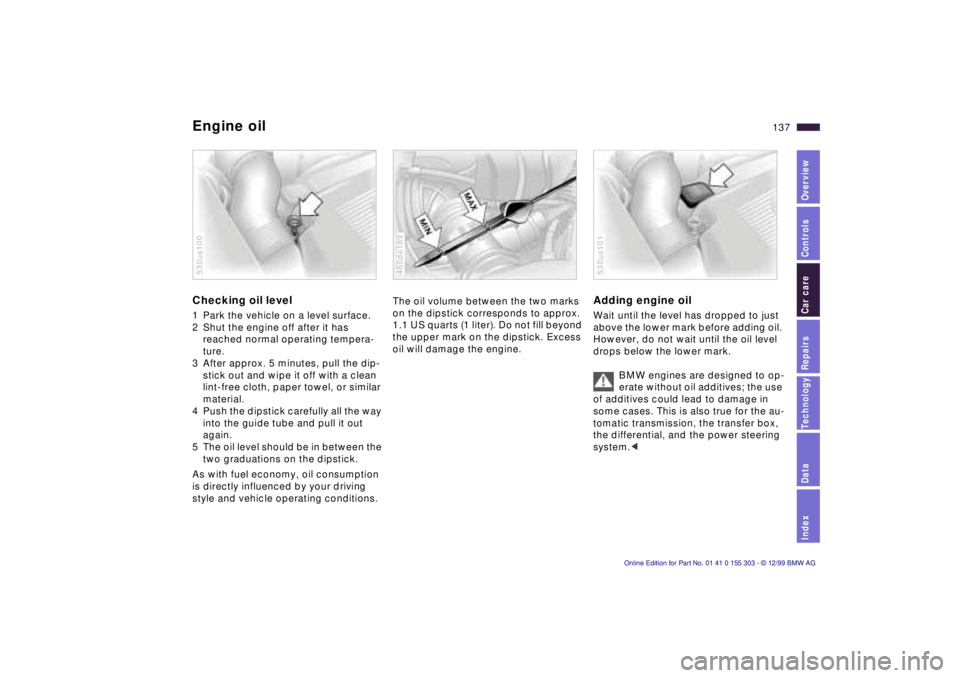
IndexDataTechnologyRepairsCar careControlsOverview
137n
Engine oil Checking oil level 1 Park the vehicle on a level surface.
2 Shut the engine off after it has
reached normal operating tempera-
ture.
3 After approx. 5 minutes, pull the dip-
stick out and wipe it off with a clean
lint-free cloth, paper towel, or similar
material.
4 Push the dipstick carefully all the way
into the guide tube and pull it out
again.
5 The oil level should be in between the
two graduations on the dipstick.
As with fuel economy, oil consumption
is directly influenced by your driving
style and vehicle operating conditions. 530us100
The oil volume between the two marks
on the dipstick corresponds to approx.
1.1 US quarts (1 liter). Do not fill beyond
the upper mark on the dipstick. Excess
oil will damage the engine. 460de189
Adding engine oil Wait until the level has dropped to just
above the lower mark before adding oil.
However, do not wait until the oil level
drops below the lower mark.
BMW engines are designed to op-
erate without oil additives; the use
of additives could lead to damage in
some cases. This is also true for the au-
tomatic transmission, the transfer box,
the differential, and the power steering
system.< 530us101
Page 142 of 201
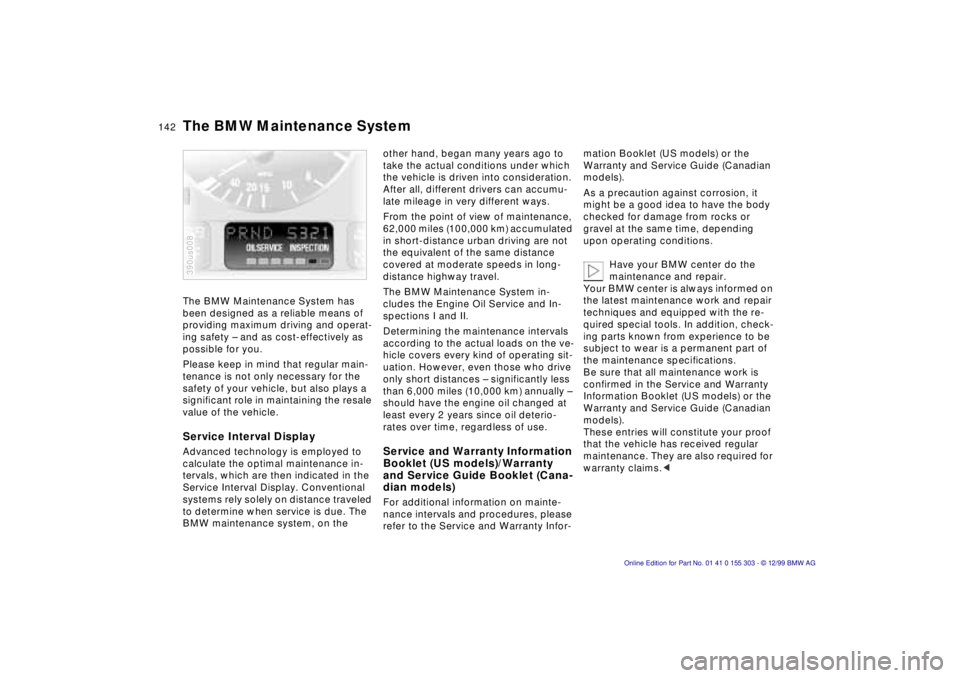
142n
The BMW Maintenance System has
been designed as a reliable means of
providing maximum driving and operat-
ing safety Ð and as cost-effectively as
possible for you.
Please keep in mind that regular main-
tenance is not only necessary for the
safety of your vehicle, but also plays a
significant role in maintaining the resale
value of the vehicle.
Service Interval Display Advanced technology is employed to
calculate the optimal maintenance in-
tervals, which are then indicated in the
Service Interval Display. Conventional
systems rely solely on distance traveled
to determine when service is due. The
BMW maintenance system, on the 390us008
other hand, began many years ago to
take the actual conditions under which
the vehicle is driven into consideration.
After all, different drivers can accumu-
late mileage in very different ways.
From the point of view of maintenance,
62,000 miles (100,000 km) accumulated
in short-distance urban driving are not
the equivalent of the same distance
covered at moderate speeds in long-
distance highway travel.
The BMW Maintenance System in-
cludes the Engine Oil Service and In-
spections I and II.
Determining the maintenance intervals
according to the actual loads on the ve-
hicle covers every kind of operating sit-
uation. However, even those who drive
only short distances Ð significantly less
than 6,000 miles (10,000 km) annually Ð
should have the engine oil changed at
least every 2 years since oil deterio-
rates over time, regardless of use. Service and Warranty Information
Booklet (US models)/Warranty
and Service Guide Booklet (Cana-
dian models) For additional information on mainte-
nance intervals and procedures, please
refer to the Service and Warranty Infor-mation Booklet (US models) or the
Warranty and Service Guide (Canadian
models).
As a precaution against corrosion, it
might be a good idea to have the body
checked for damage from rocks or
gravel at the same time, depending
upon operating conditions.
Have your BMW center do the
maintenance and repair.
Your BMW center is always informed on
the latest maintenance work and repair
techniques and equipped with the re-
quired special tools. In addition, check-
ing parts known from experience to be
subject to wear is a permanent part of
the maintenance specifications.
Be sure that all maintenance work is
confirmed in the Service and Warranty
Information Booklet (US models) or the
Warranty and Service Guide (Canadian
models).
These entries will constitute your proof
that the vehicle has received regular
maintenance. They are also required for
warranty claims.<
The BMW Maintenance System
Page 165 of 201
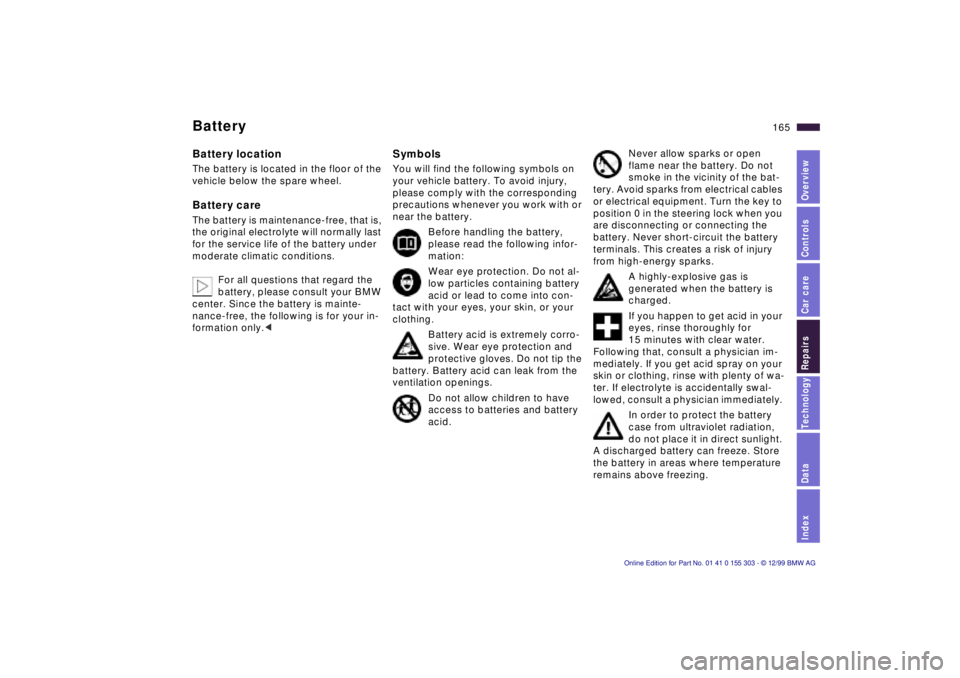
IndexDataTechnologyRepairsCar careControlsOverview
165n
Battery Battery location The battery is located in the floor of the
vehicle below the spare wheel. Battery care The battery is maintenance-free, that is,
the original electrolyte will normally last
for the service life of the battery under
moderate climatic conditions.
For all questions that regard the
battery, please consult your BMW
center. Since the battery is mainte-
nance-free, the following is for your in-
formation only.<
Symbols You will find the following symbols on
your vehicle battery. To avoid injury,
please comply with the corresponding
precautions whenever you work with or
near the battery.
Before handling the battery,
please read the following infor-
mation:
Wear eye protection. Do not al-
low particles containing battery
acid or lead to come into con-
tact with your eyes, your skin, or your
clothing.
Battery acid is extremely corro-
sive. Wear eye protection and
protective gloves. Do not tip the
battery. Battery acid can leak from the
ventilation openings.
Do not allow children to have
access to batteries and battery
acid.
Never allow sparks or open
flame near the battery. Do not
smoke in the vicinity of the bat-
tery. Avoid sparks from electrical cables
or electrical equipment. Turn the key to
position 0 in the steering lock when you
are disconnecting or connecting the
battery. Never short-circuit the battery
terminals. This creates a risk of injury
from high-energy sparks.
A highly-explosive gas is
generated when the battery is
charged.
If you happen to get acid in your
eyes, rinse thoroughly for
15 minutes with clear water.
Following that, consult a physician im-
mediately. If you get acid spray on your
skin or clothing, rinse with plenty of wa-
ter. If electrolyte is accidentally swal-
lowed, consult a physician immediately.
In order to protect the battery
case from ultraviolet radiation,
do not place it in direct sunlight.
A discharged battery can freeze. Store
the battery in areas where temperature
remains above freezing.
Page 166 of 201

166n
Battery Charging the battery Charge the battery in the vehicle only
when the engine is not running. Use the
connections provided in the engine
compartment (for correct connections,
refer to "Jump-starting" on page 170).
The service life specified for the
battery can be achieved only if it
is always kept adequately charged.
Have the charge condition of the bat-
tery checked frequently if the vehicle
is used primarily for driving short
distances.<
Before performing any work on
the electrical system, disconnect
the cable from the negative terminal. If
you do not, short circuits can create the
risk of fire or personal injury.<
If you plan to park the vehicle longer
than 4 weeks, have the battery discon-
nected from the vehicle's electrical
system by disconnecting the cable from
the negative terminal. Then have the
battery charged with an appropriate
battery charger.
If the vehicle will not be driven for a
period longer than 12 weeks, have the
battery removed, charged and store it
in a clean and cool (frost-free) area.
Recharge the battery at least every
three months during storage. Also,
recharge the battery before it is in-
stalled. If you fail to do so, it will not be
serviceable. Every time the battery is
discharged, especially over extended
periods, its service life is reduced. Do not disconnect the battery
when the engine is running. If
you do so, the ensuing voltage surge
will damage the vehicle's onboard elec-
tronics.
Do not make any modifications in the
wires to the positive terminal. If you do
so, the protective function of the safety
battery terminal is no longer ensured.
Repair and disposal must be performed
by trained technicians only.<
Return used batteries to a recy-
cling point or your authorized
BMW center. Maintain the battery in an
upright position for transport and stor-
age. Secure the battery against tilting in
transit.<
Page 176 of 201
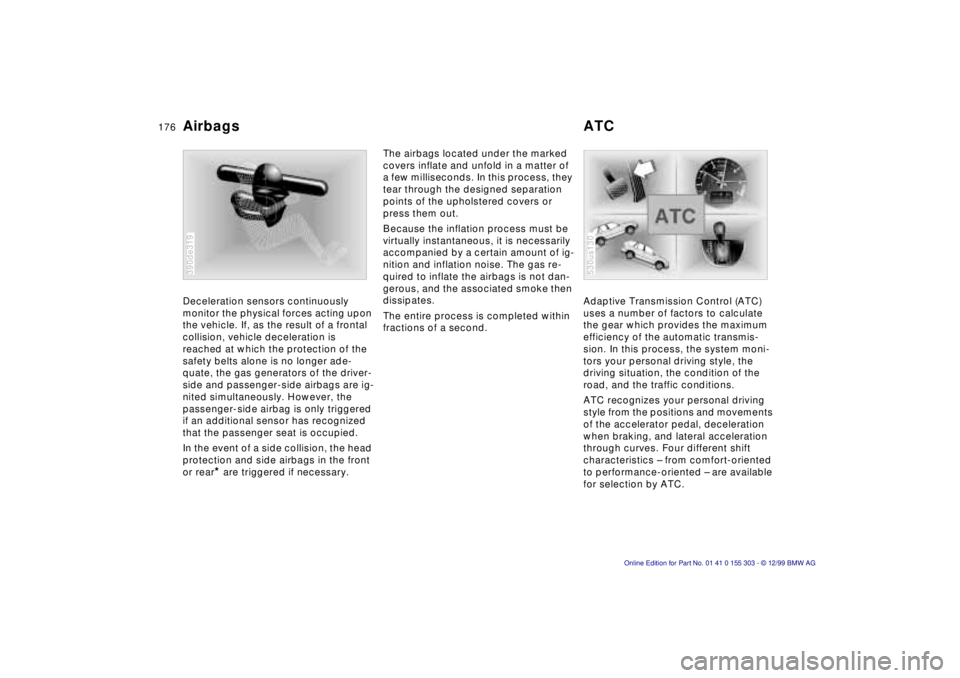
176n
Deceleration sensors continuously
monitor the physical forces acting upon
the vehicle. If, as the result of a frontal
collision, vehicle deceleration is
reached at which the protection of the
safety belts alone is no longer ade-
quate, the gas generators of the driver-
side and passenger-side airbags are ig-
nited simultaneously. However, the
passenger-side airbag is only triggered
if an additional sensor has recognized
that the passenger seat is occupied.
In the event of a side collision, the head
protection and side airbags in the front
or rear
* are triggered if necessary.
390de319
The airbags located under the marked
covers inflate and unfold in a matter of
a few milliseconds. In this process, they
tear through the designed separation
points of the upholstered covers or
press them out.
Because the inflation process must be
virtually instantaneous, it is necessarily
accompanied by a certain amount of ig-
nition and inflation noise. The gas re-
quired to inflate the airbags is not dan-
gerous, and the associated smoke then
dissipates.
The entire process is completed within
fractions of a second. Adaptive Transmission Control (ATC)
uses a number of factors to calculate
the gear which provides the maximum
efficiency of the automatic transmis-
sion. In this process, the system moni-
tors your personal driving style, the
driving situation, the condition of the
road, and the traffic conditions.
ATC recognizes your personal driving
style from the positions and movements
of the accelerator pedal, deceleration
when braking, and lateral acceleration
through curves. Four different shift
characteristics Ð from comfort-oriented
to performance-oriented Ð are available
for selection by ATC.
530us130
Airbags ATC
Page 177 of 201
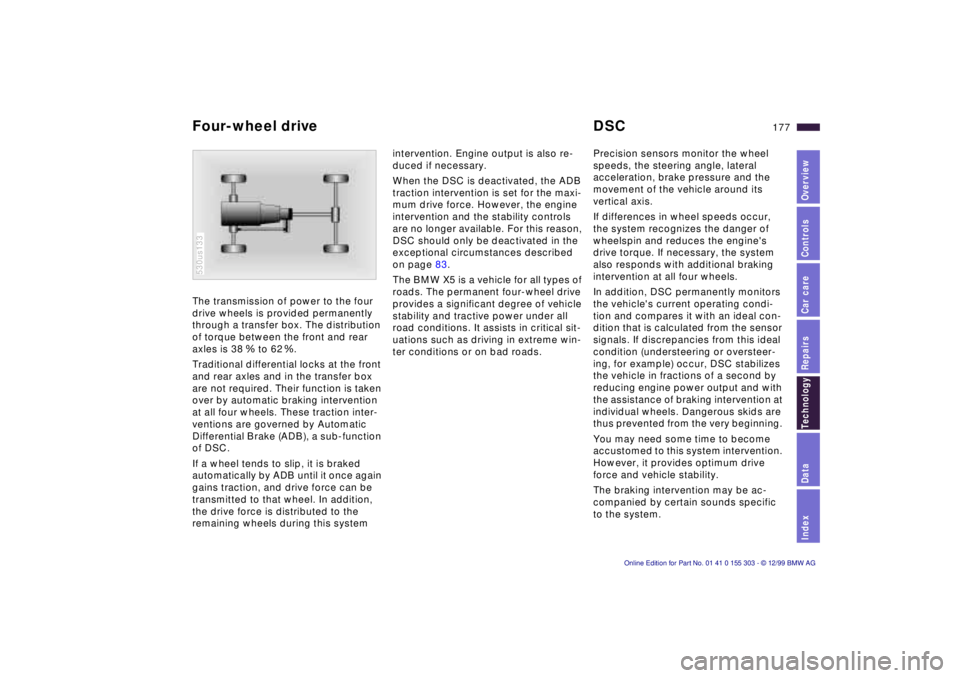
IndexDataTechnologyRepairsCar careControlsOverview
177n
The transmission of power to the four
drive wheels is provided permanently
through a transfer box. The distribution
of torque between the front and rear
axles is 38% to 62%.
Traditional differential locks at the front
and rear axles and in the transfer box
are not required. Their function is taken
over by automatic braking intervention
at all four wheels. These traction inter-
ventions are governed by Automatic
Differential Brake (ADB), a sub-function
of DSC.
If a wheel tends to slip, it is braked
automatically by ADB until it once again
gains traction, and drive force can be
transmitted to that wheel. In addition,
the drive force is distributed to the
remaining wheels during this system
530us133
intervention. Engine output is also re-
duced if necessary.
When the DSC is deactivated, the ADB
traction intervention is set for the maxi-
mum drive force. However, the engine
intervention and the stability controls
are no longer available. For this reason,
DSC should only be deactivated in the
exceptional circumstances described
on page 83.
The BMW X5 is a vehicle for all types of
roads. The permanent four-wheel drive
provides a significant degree of vehicle
stability and tractive power under all
road conditions. It assists in critical sit-
uations such as driving in extreme win-
ter conditions or on bad roads. Precision sensors monitor the wheel
speeds, the steering angle, lateral
acceleration, brake pressure and the
movement of the vehicle around its
vertical axis.
If differences in wheel speeds occur,
the system recognizes the danger of
wheelspin and reduces the engine's
drive torque. If necessary, the system
also responds with additional braking
intervention at all four wheels.
In addition, DSC permanently monitors
the vehicle's current operating condi-
tion and compares it with an ideal con-
dition that is calculated from the sensor
signals. If discrepancies from this ideal
condition (understeering or oversteer-
ing, for example) occur, DSC stabilizes
the vehicle in fractions of a second by
reducing engine power output and with
the assistance of braking intervention at
individual wheels. Dangerous skids are
thus prevented from the very beginning.
You may need some time to become
accustomed to this system intervention.
However, it provides optimum drive
force and vehicle stability.
The braking intervention may be ac-
companied by certain sounds specific
to the system.
Four-wheel drive DSC
Page 179 of 201
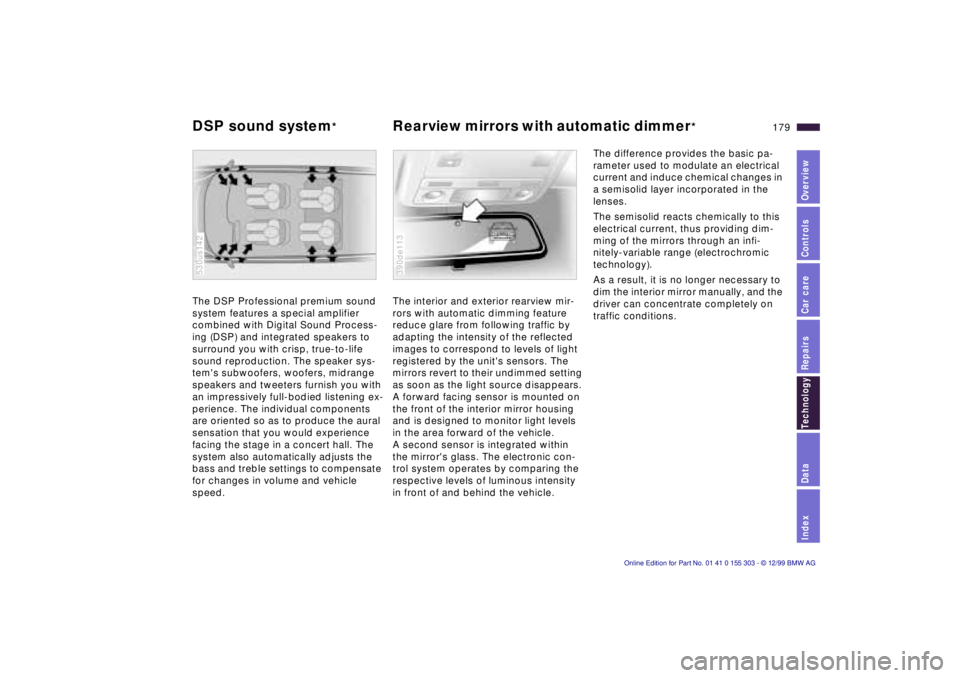
IndexDataTechnologyRepairsCar careControlsOverview
179n
DSP sound system
*
Rearview mirrors with automatic dimmer
*
The DSP Professional premium sound
system features a special amplifier
combined with Digital Sound Process-
ing (DSP) and integrated speakers to
surround you with crisp, true-to-life
sound reproduction. The speaker sys-
tem's subwoofers, woofers, midrange
speakers and tweeters furnish you with
an impressively full-bodied listening ex-
perience. The individual components
are oriented so as to produce the aural
sensation that you would experience
facing the stage in a concert hall. The
system also automatically adjusts the
bass and treble settings to compensate
for changes in volume and vehicle
speed. 530us142
The interior and exterior rearview mir-
rors with automatic dimming feature
reduce glare from following traffic by
adapting the intensity of the reflected
images to correspond to levels of light
registered by the unit's sensors. The
mirrors revert to their undimmed setting
as soon as the light source disappears.
A forward facing sensor is mounted on
the front of the interior mirror housing
and is designed to monitor light levels
in the area forward of the vehicle.
A second sensor is integrated within
the mirror's glass. The electronic con-
trol system operates by comparing the
respective levels of luminous intensity
in front of and behind the vehicle. 390de113
The difference provides the basic pa-
rameter used to modulate an electrical
current and induce chemical changes in
a semisolid layer incorporated in the
lenses.
The semisolid reacts chemically to this
electrical current, thus providing dim-
ming of the mirrors through an infi-
nitely-variable range (electrochromic
technology).
As a result, it is no longer necessary to
dim the interior mirror manually, and the
driver can concentrate completely on
traffic conditions.
Page 181 of 201
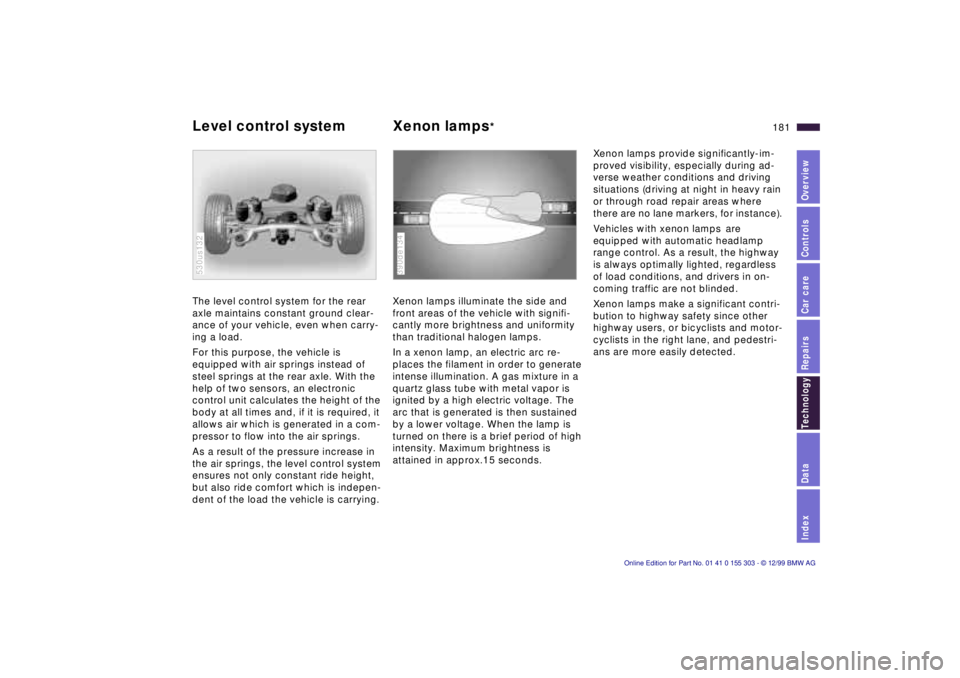
IndexDataTechnologyRepairsCar careControlsOverview
181n
Level control system
Xenon lamps
*
The level control system for the rear
axle maintains constant ground clear-
ance of your vehicle, even when carry-
ing a load.
For this purpose, the vehicle is
equipped with air springs instead of
steel springs at the rear axle. With the
help of two sensors, an electronic
control unit calculates the height of the
body at all times and, if it is required, it
allows air which is generated in a com-
pressor to flow into the air springs.
As a result of the pressure increase in
the air springs, the level control system
ensures not only constant ride height,
but also ride comfort which is indepen-
dent of the load the vehicle is carrying. 530us132
Xenon lamps illuminate the side and
front areas of the vehicle with signifi-
cantly more brightness and uniformity
than traditional halogen lamps.
In a xenon lamp, an electric arc re-
places the filament in order to generate
intense illumination. A gas mixture in a
quartz glass tube with metal vapor is
ignited by a high electric voltage. The
arc that is generated is then sustained
by a lower voltage. When the lamp is
turned on there is a brief period of high
intensity. Maximum brightness is
attained in approx.15 seconds. 390de134
Xenon lamps provide significantly-im-
proved visibility, especially during ad-
verse weather conditions and driving
situations (driving at night in heavy rain
or through road repair areas where
there are no lane markers, for instance).
Vehicles with xenon lamps
are
equipped with automatic headlamp
range control. As a result, the highway
is always optimally lighted, regardless
of load conditions, and drivers in on-
coming traffic are not blinded.
Xenon lamps make a significant contri-
bution to highway safety since other
highway users, or bicyclists and motor-
cyclists in the right lane, and pedestri-
ans are more easily detected.